The Friends of the Wildflower Garden, Inc.
Plants of the Eloise Butler Wildflower Garden
The oldest public wildflower garden in the United States
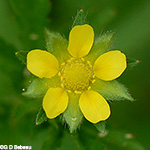
Common Name
Rough Cinquefoil (Norwegian cinquefoil, Strawberry Weed)
Scientific Name
Potentilla norvegica L.
Plant Family
Rose (Rosaceae)
Garden Location
Woodland, but may not be extant.
Prime Season
Early Summer Flowering
Rough Cinquefoil is an erect forb that can be annual, biennial or a short lived perennial. It begins life with a basal rosette, later sending up a flowering stalk from 1 to 3 feet high. The stem is leafy, hairy, and usually branched near the top, green initially then turning to a dull reddish-purple. Lower stem hairs are usually stiff and usually without glands. There are both Eurasian and native populations found in North America.
Leaves, both basal and on the stem, are slightly hairy on top, more so on the underside, are 3-parted with each elliptical to oval leaflet 2 to 3 inches long, tapering to the base, with slightly rounded edges on the teeth, some of which are double. The basal leaves have long hairy leaf stalks while the stem leaves are alternate with shorter stalks. The uppermost leaves are stalkless.
The inflorescence is a tight branched cluster (a cyme) or clusters, as several may form on the upper branches. Solitary flowers also occur from the upper leaf stalks.
Flowers: Each pale yellow 5-parted flower is only 1/3 to 1/2 inch wide with gaps between the 5 yellow petals through which appear the 5 green hairy calyx lobes (sepals) that are longer than the petals. Petals are obovate in shape (widest in the center, length about 1.5x the width) and widely spaced. Just below the sepals are 5 still longer green spreading bracts that are more triangular shaped. The flower has 15 or 20 stamens with yellow filaments and broad yellow anthers in a circular pattern around a dome shaped center receptacle containing 60 to 150 carpels with their thread-like styles. Flowers do not all bloom at once, giving an extended bloom period of a month or more for the plant.
Seed: In fertile flowers, the long calyx lobes (sepals) fold upward and over the flower head forming a cone like protective structure until the seeds (dry flattened achenes without a pappus) are mature and are scattered from the plant by wind action on the tall stem. Regeneration is from re-seeding. The achenes are tan to brown, 0.8 to 1.3 mm long.
Habitat: Rough Cinquefoil is found in many sites, from dry to slightly moist soils, in full sun to partial shade. As it regenerates from seed, it usually takes hold along edgeways where seedlings are not crowded out by more vigorous perennial vegetation. Native North American populations prefer more moist sites
Names: The genus name, Potentilla, is from the Latin word potens, meaning 'powerful' and refers to the medicinal power of some species of the genus which have medicinal properties. The species name, norvegica, means "of Norway" and perhaps is a reference to whose settlers brought the plant to North America. The old common name of Strawberry Weed is due to the similarity of the leaves of a young plant to the common strawberry. The author name for the plant classification from 1753 - 'L.' refers to Carl Linnaeus (1707-1778), Swedish botanist and the developer of the binomial nomenclature of modern taxonomy.
The Pontentilla are are large genus of about 400 species. These have been separated into sections. P. norvegica is in section Rivales which is composed of those species that are primarily annuals, biennials, or short-lived perennials. See Flora of North America (Ref. #W7) for a complete key.
Comparisons: Another non-native Cinquefoil that is similar to this species is P. recta, the Rough-fruited Cinquefoil. But there the lower leaves are 5 to 7 parted and the flower sepals and bracts are much shorter than the petals.
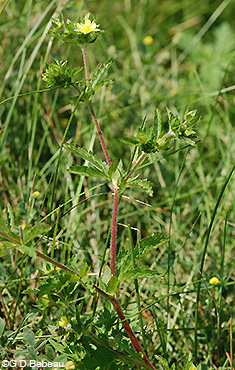
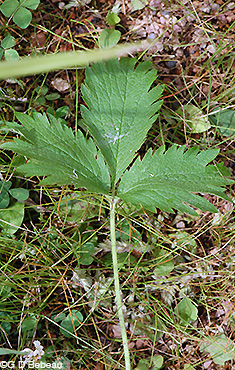
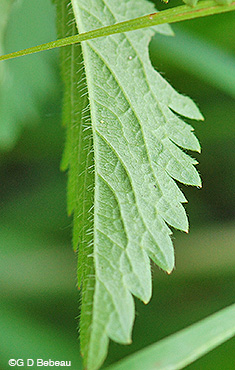
Above: - Note the several cymes branching at the top of the dull reddish stem. Leaves: 2nd photo is a long stalked basal leaf. The shape of that leaf gives the plant its alternate common name of "Strawberry Weed". 3rd photo - note the hair on the underside especially on the mid-vein and the double-teeth.
Below: The petals have clawed bases, tips are not notched. Between them appear the slightly longer hairy green calyx lobes (the sepals), and behind the petals are the longer hairy bracts. 2nd photo - this example has 15 stamens with thick yellow anthers.

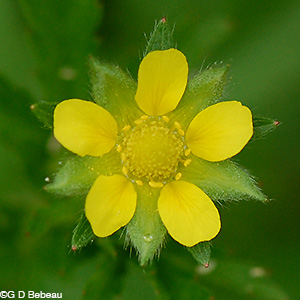
Below: 1st photo - A typical 3-parted upper stem leaf without a stalk. 2nd photo - All the upper parts have long fine hair - the stem, the leaves, the bracts and the sepals.

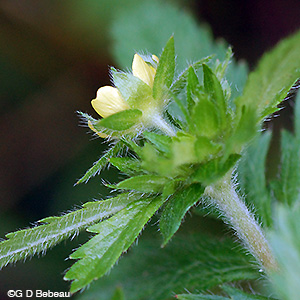
Below: Seeds of Rough Cinquefoil
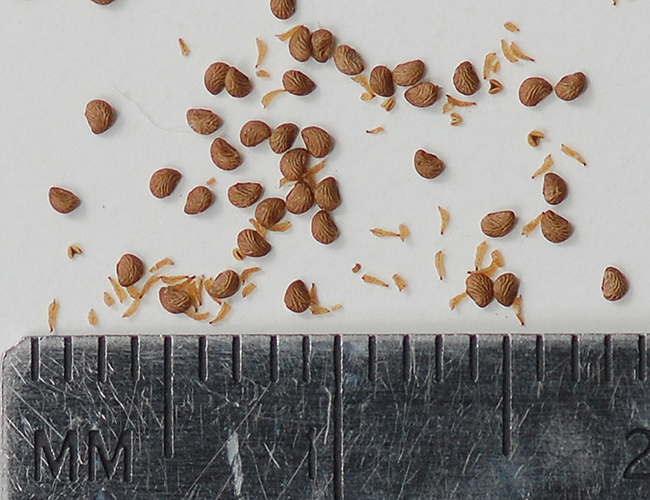
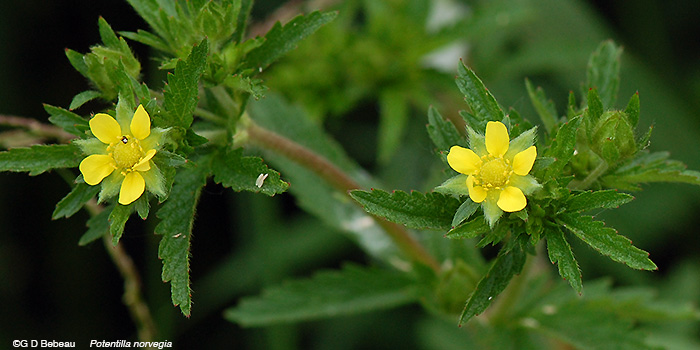
Notes: Rough Cinquefoil is indigenous to the Garden. Eloise Butler first noted in her Garden log on June 26, 1910. Martha Crone listed it on her 1951 census as P. hirsuta, which is a name that is not accepted although some botanists in past years used hirsuta as variety or subspecies of P. norvegica. It was still in the Garden at the time of the 1986 census but has since gone missing.
Rough Cinquefoil is widespread throughout North America. There are native populations and populations of the Eurasian species that was introduced to the continent during the early colonial period. It is found in all Canadian Provinces and all US States except Louisiana, Mississippi and Florida. Within Minnesota it has been found in the vast majority of the counties with exceptions widely scattered. It is found in most metro counties and it has been in the state so long that most references consider it to be native, although as Flora of North America states it is a huge challenge to determine if a population is native or introduced. There are 18 Cinquefoils in the genus Potentilla that have been reported in Minnesota of which 2 are introductions. Four of those 18 have not been collected and are thought to be erroneous. Of the remaining 14, several are known from only one county.
Two other cinquefoils are present in the Garden - P. recta, Rough Fruited Cinquefoil; and P. simplex,Common Cinquefoil.
Return to -- Site Plan/Archive Index --or-- List of Common Plant Names -- or -- List of Scientific Names -- or --Home Page - - - Back to top.
References: Plant characteristics are generally from sources 1A, 32, W2, W3, W7 & W8 plus others as specifically applied. Distribution principally from W1, W2 and 28C. Planting history generally from 1, 4 & 4a. Other sources by specific reference. See Reference List for details.
 Identification booklet for most of the flowering forbs and small flowering shrubs of the Eloise Butler Wildflower Garden. Details Here.
Identification booklet for most of the flowering forbs and small flowering shrubs of the Eloise Butler Wildflower Garden. Details Here.
©2013
Friends of the Wildflower Garden, Inc. Text and photos are by G. D. Bebeau unless otherwise credited. "www.friendsofeloisebutler.org"
081420